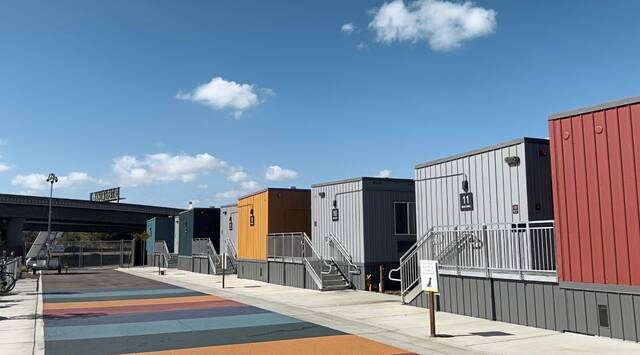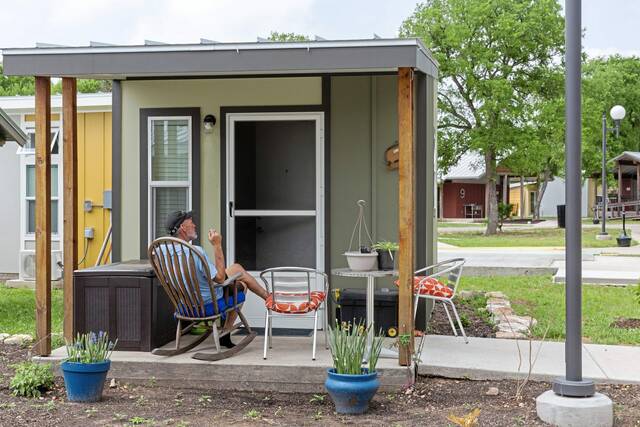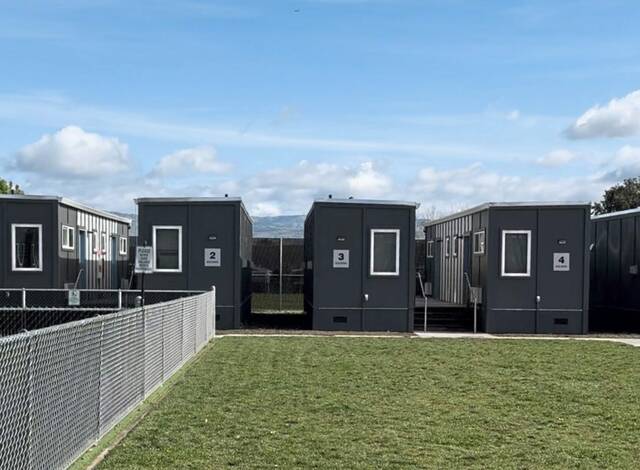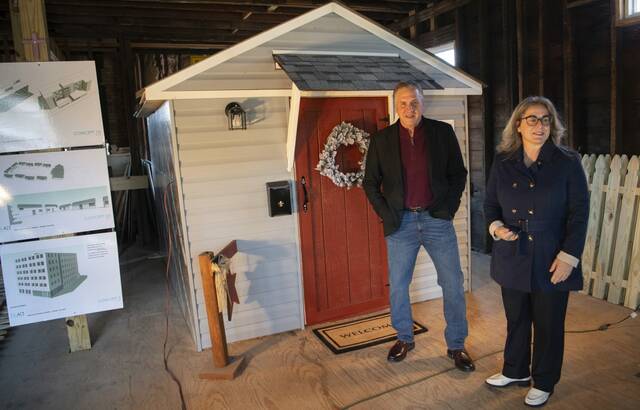Tiny houses make big impact out west, emerge as possible fix for Pittsburgh homeless crisis
Pittsburgh politicians are looking west for ways to fix the city’s homeless crisis, hoping to mimic a small but successful solution far from Pennsylvania’s borders.
Inspired by an initiative launched in Colorado, some Pittsburgh City Council members are pushing for tiny houses — pint-sized, private structures where homeless people can have their own locking doors and even utilities in some cases.
Advocates argue that tiny houses are a better, safer alternative to the perennial tent cities that have popped up in parks, under overpasses and along riverfronts in the Golden Triangle. But local proposals to forge ahead have been mired in bureaucracy and legal concerns raised by Mayor Ed Gainey’s administration.
The Pittsburgh Planning Commission is considering legislation that could open the way for tracts of tiny houses Downtown, though a critical vote that had been scheduled for Tuesday has been postponed. Regardless of when the commission takes up the issue, the experience of other cities shows that the small, semi-permanent structures can perhaps succeed where other efforts haven’t.
Cole Chandler, Denver’s senior advisor for homeless resolution, has had first-hand experience with rolling out tiny houses in the mile-high city.
“This effort has truly transformed Denver,” Chandler told TribLive recently. “It’s a place where individuals who were once living in tents on the streets now have access to homes of their own.”
Right now, Pittsburgh’s homeless residents have a stark choice: either brave the streets or risk staying at group shelters, where some people are concerned they could fall victim to crime in a setting that lacks privacy.
Tiny houses could offer a middle path, according to supporters, who view them as a stopgap measure to help homeless people as officials work to build more permanent affordable housing.
Despite pushback, more and more municipalities are turning to tiny homes for their homeless populations, said Steve Berg, chief policy officer with the National Alliance to End Homelessness, a nonprofit. In addition to Colorado, tiny house communities have risen in California and Texas.
The trend, Berg said, largely took off during the covid-19 pandemic, when officials wanted to avoid cramming people together in the close quarters of group shelters.
Since then, he said, people have been calling for more permanent options like tiny houses where residents have their own space.
“I think we definitely heard the same thing from all over the country,” Berg said. “It’s not to say all group shelters are bad. If they’re kept up well and staffed sufficiently, then they can be places where people are very happy to come. But for the most part, we’re hearing from a lot of people who are homeless that noncongregate shelters are better.”
The experiences of some cities, however, also illustrate potential pitfalls faced by the tiny-house model.
Alan Graham, founder and CEO of Mobile Loaves & Fishes, opened the Community First! tiny house village just outside of Austin, Texas in 2015. The 51-acre site currently houses 450 people.
The community — which includes a variety of tiny house designs, many of which are painted bright colors and feature covered porches — is “not nirvana,” he said, but it has provided hope to many homeless people who had lost their dignity living under bridges and on street corners.
“This is the right thing to do,” Graham said. “It’s not the answer to homelessness, but it’s a very powerful tool in the toolbox.”
All shapes and sizes
Tiny house communities come in various shapes and sizes, from sprawling communities housing hundreds to smaller villages with just a few dozen residents.
Some structures come with their own bathrooms and kitchens. Others are little more than small sheds with beds and access to shared facilities. They’ve been built in residential areas and commercial hubs. They boast various amenities such as dog parks and small farms. And they have on-site services such as recovery programs for drug users and help for job searchers.
In some cities, they’re built with taxpayer dollars. In other places, nonprofits chip in some or all of the costs.
Pittsburgh Councilman Anthony Coghill, D-Beechview, built a stripped-down prototype in Pittsburgh for less than $2,000, while other tiny house sites come with price tags of up to $150,000 per unit, including costs to hook up utilities and other amenities.
Officials and outreach workers say tiny house communities have one thing in common — they provide a safer, more dignified alternative to sleeping on the streets.
While many of these communities have opened only in recent years, early indications show the initiative reduces the number of unsheltered homeless people, is more readily accepted than group shelters and can offer a more successful path to permanent housing.
Pittsburgh’s tiny house proposal is also being championed by Councilwoman Deb Gross, D-Highland Park.
Together, Coghill and Gross are touting the structures as a quick, affordable, stopgap solution to get Pittsburgh’s roughly 200 unsheltered homeless people into more dignified living arrangements.
As the pair researched options for Pittsburgh, they modeled their proposal off a template in Denver.
Rocky Mountain solution
Since July, the Colorado capital has brought about 1,300 of its 1,423 unsheltered homeless people inside by placing them in tiny houses, Chandler said. More than 95% of the homeless people who were offered a tiny house accepted.
Denver’s tiny houses, which Chandler described as “small cabins” built in a “hub-and-spoke model” around a community center with common amenities, are adorned with decals from a local artist depicting Colorado flags, flowers and bighorn sheep “to make it feel like home and locate it within our state.”
Three months later, nearly all of the people who had moved into tiny those tiny houses were still indoors, according to Chandler.
Denver’s rollout hasn’t lacked controversy, however.
Residents such as Megan Williams successfully prodded officials to scrap plans for a tiny house community designed to shelter up to 200 homeless people.
Williams told TribLive that she was concerned about the size of the planned community, its location in her neighborhood and the fast track on which she felt Denver officials put the project.
“When you’re trying to house more than 1,000 people, you cut corners,” she said. “And you bypass zoning, you bypass permitting, and it really takes just a common civilian off guard.”
Alec Baker, another Denver resident, said he initially thought small tiny-house blocs would be good. He liked the idea of tight-knit communities where people could get the services they need.
But he balked at the larger communities that Denver rolled out, housing hundreds of people at one site.
He described them as “holding pens” and said he felt the scope “has definitely gotten out of hand” to the point where there wasn’t enough staffing to meet everyone’s needs.
Baker said the homeless people who had been camping mere feet from his property line have relocated since the tiny-house communities have opened. But he doesn’t want to see more homeless people back in his neighborhood at such a site.
These communities, he said, should be set up away from residents.
“I don’t think it’s fair to say to people that they have to choose between a (homeless) facility on their street or a person camping in their backyard,” he said. “Ultimately, it’s none of the above. Homeowners are going to feel threatened because their livelihoods are tied up in their homes.”
Related:
• Homeless encampments with electricity, water proposed by Pittsburgh officials
• Pittsburgh commission to vote on controversial plan addressing homelessness
• Pittsburgh Planning Commission delays vote on controversial plan to help homeless
West Coast experience
San Jose opened its first tiny houses in early 2020. The city has nearly 500 scattered across five sites.
About 1,600 people have lived in them since the program launched, said Mackenzie Mossing, chief policy officer for San Jose’s mayor.
The majority of them remain housed, with about half of the people who have done stints in tiny houses now living in permanent housing. That’s compared to about 20-30% of people who find permanent housing from group shelters.
On average, Mossing said, people stay in a tiny house for three to six months before moving on to permanent or transitional housing.
Mossing credits the tiny houses for a 10.7% drop in San Jose’s homeless population since 2020, following a decade when that number had grown.
Mossing said the tiny houses offer people a better way to stabilize and transition from homelessness to self-sufficiency.
“You’re taking people out of an unmanaged, unsafe setting and moving them into a managed setting,” she said. “People are realizing we really need these.”
Mossing described the tiny houses used in San Jose as “shipping containers on steroids” divided into living quarters with bathrooms. They cost between $100,000 and $150,000 and can be built within a year.
Mossing said the tiny house communities haven’t been linked to an increase in crime or other problems. Instead, calls for first responders have decreased within a half-mile radius of new tiny house communities opening, she said.
Sacramento County opened its first tiny house community in August, a 150-unit site just outside the southern limits of the city of Sacramento.
Within six months, more than a dozen people had gone from a tiny house to something more permanent — a strong measure of success, according to Janna Haynes, a county spokeswoman.
Security is on site 24 hours a day, Haynes said, so there’s been “almost no crime.” Residents have their own private spaces with locking doors, plus access to services including resume-writing guidance and mental health support. There’s even a dog park and computer access.
The tiny house units used in Sacramento are made of aluminum. They’re movable and can be put up within about an hour. Tiny houses for individuals are 8 feet by 8 feet, while doubles for couples are 8 feet by 16 feet. They come equipped with fold-out beds, shelving, HVAC, electricity and smoke alarms.
Haynes acknowledged some Sacramento residents have been wary. But, she said, the positives of tiny-house communities have been apparent.
“People see a visible change in their neighborhood,” she said. “There are less tents. There’s less camping. They’ve been functioning as we intended them to.”
Could it happen here?
Officials in Pittsburgh are divided on tiny houses. All sides agree, though, that the city doesn’t have enough shelters or permanent housing to meet the needs of those now sleeping on the streets.
Most of the available overnight beds are in group shelters, which many homeless people reject for fear they could fall victim to theft or violence in a setting that lacks privacy or security.
Ronald Taylor said he’s been homeless so long he doesn’t remember exactly when he started sleeping on the streets. After a long, cold night in March, he was so tired he struggled to stay awake while talking with outreach workers on the North Side.
The lifelong Pittsburgher had been sleeping on the porch of a recently vacated North Shore building when Light of Life outreach workers convinced him in mid-March to go to a shelter for the first time.
Taylor said he was “apprehensive.”
But when the conversation with a TribLive reporter pivoted to the topic of tiny houses, his pale blue eyes lit up. He said he wished that was an option to get him off the cold sidewalk.
“I would love that,” he said. “That’s what I really want. That’s the type of situation I would love to have.”
Mike Eberhardt grew up in Pittsburgh’s Manchester neighborhood on the North Side. But for the past seven years, he’s been homeless. He mostly couch surfs, staying with friends and family while shunning group shelters because “everybody doesn’t have morals.”
But sometimes, when he doesn’t want to be around other people, Eberhardt sleeps on the street.
Asked if he would accept a tiny house if Pittsburgh had such an option, the 47-year-old replied, “of course.”
Ideally, he said, such a community would have security and supportive services so people could feel safe and get the help they need to find permanent housing and get back on their feet.
Interim solution
Berg, the official with the National Alliance to End Homelessness, said tiny house communities seem to be helping people transition from unsheltered homelessness to permanent housing.
But it’s imperative that officials also look at more permanent ways to address homelessness, like bolstering the stock of truly affordable housing, he said.
Even the people running tiny house communities agree that more permanent affordable housing is needed. Tiny homes are meant to be only an interim solution.
Elizabeth Funk is the founder and CEO of DignityMoves, which operates several tiny home communities in nine California cities. She said she founded DignityMoves because people can’t be expected to live long-term on the streets while waiting for permanent housing to be built — an expensive process that often takes years.
“The idealism is in conflict with the reality,” Funk said.
Tiny houses, she said, can fill that critical gap.
In San Francisco, for every homeless person who gets permanent housing, four more fall into homelessness, she said.
In many places, officials can’t build enough affordable housing to keep up with the growing number of homeless.
Doing something
Funk compared the homeless crisis to witnessing a car crash. If someone sees a wreck, she said, they stop and help. It doesn’t matter if cars aren’t allowed to pull over or if the cloth used to stop the bleeding isn’t medical grade. In an emergency, doing something to help is better than waiting around doing nothing.
“If the jurisdiction truly believes they have a crisis, then you treat it like a crisis,” she said.
Some places have used emergency declarations to cut red tape or passed legislative measures aimed at making it easier to build shelters or transitional housing with fewer hurdles.
Any tiny house communities built in Downtown Pittsburgh for the city’s homeless population would require a change in the zoning code.
The planning commission was supposed to tackle the issue in February but delayed action for eight weeks — and then postponed it again with the approval of Coghill and Gross as the pair try to hammer out a compromise with the mayor’s office. At some point, the commission will vote and issue a non-binding recommendation to City Council.
The proposal has drawn divided reactions.
Gainey’s administration has voiced worries that tiny houses don’t fit well into the city’s zoning code. Other municipalities have legislated their way out of similar concerns.
The mayor’s office has also claimed that regulating some homeless camps would force the city to tear down the rest.
City Council’s solicitor has dismissed that concern. And officials in other places where tiny house communities have gone up haven’t encountered such a problem.
Councilwoman Erika Strassburger, D-Squirrel Hill — who joined Coghill and Gross on a committee to address homelessness — said she’s heard both support and opposition from constituents. She favors the concept.
“I think any initiative that can work rapidly to house people, to give people healthy places to live, safe places to live, so they’re out of their tents, out of the cold, off of busy streets, is a very big positive,” she said. “We want every person in Pittsburgh to have dignity. Having a home — or even a tiny house, or a single-occupancy room — is a start.”
As Pittsburgh’s leaders grapple with how to solve the city’s homeless challenges, they don’t have to look as far as Colorado and California for examples. Pennsylvania’s capital is poised to see its first tiny house plan open soon — 15 units on five acres of riverfront green space. The Harrisburg homes are earmarked for local veterans, said Diane McNaughton, who works with Veterans Outreach of Pennsylvania.
One veteran, she said, is already sleeping outside the site, waiting for a tiny house.
Julia Felton is a TribLive reporter covering Pittsburgh City Hall and other news in and around Pittsburgh. A La Roche University graduate, she joined the Trib in 2020. She can be reached at jfelton@triblive.com.
Remove the ads from your TribLIVE reading experience but still support the journalists who create the content with TribLIVE Ad-Free.







